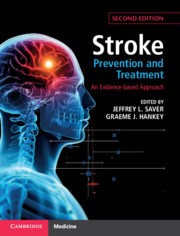Book contents
- Stroke Prevention and Treatment
- Stroke Prevention and Treatment
- Copyright page
- Dedication
- Contents
- Contributors
- Preface
- Part I Foundations
- Part II Systems of Care
- Part III Acute Treatment of Ischaemic Stroke and Transient Ischaemic Attack
- Chapter 5 Supportive Care during Acute Cerebral Ischaemia
- Chapter 6 Reperfusion of Ischaemic Brain by Intravenous Thrombolysis
- Chapter 7 Reperfusion of the Ischaemic Brain by Endovascular Thrombectomy and Thrombolysis
- Chapter 8 Collateral Flow Enhancement: Blood Pressure Lowering and Alteration of Blood Viscosity
- Chapter 9 Acute Antiplatelet Therapy for the Treatment of Ischaemic Stroke and Transient Ischaemic Attack
- Chapter 10 Acute Anticoagulant Therapy for the Treatment of Acute Ischaemic Stroke and Transient Ischaemic Attack
- Chapter 11 Treatment of Brain Oedema
- Chapter 12 Neuroprotection for Acute Brain Ischaemia
- Part IV Acute Treatment of Haemorrhagic Stroke
- Part V Prevention
- Part VI Stroke Rehabilitation and Recovery
- Index
- References
Chapter 5 - Supportive Care during Acute Cerebral Ischaemia
from Part III - Acute Treatment of Ischaemic Stroke and Transient Ischaemic Attack
Published online by Cambridge University Press: 15 December 2020
- Stroke Prevention and Treatment
- Stroke Prevention and Treatment
- Copyright page
- Dedication
- Contents
- Contributors
- Preface
- Part I Foundations
- Part II Systems of Care
- Part III Acute Treatment of Ischaemic Stroke and Transient Ischaemic Attack
- Chapter 5 Supportive Care during Acute Cerebral Ischaemia
- Chapter 6 Reperfusion of Ischaemic Brain by Intravenous Thrombolysis
- Chapter 7 Reperfusion of the Ischaemic Brain by Endovascular Thrombectomy and Thrombolysis
- Chapter 8 Collateral Flow Enhancement: Blood Pressure Lowering and Alteration of Blood Viscosity
- Chapter 9 Acute Antiplatelet Therapy for the Treatment of Ischaemic Stroke and Transient Ischaemic Attack
- Chapter 10 Acute Anticoagulant Therapy for the Treatment of Acute Ischaemic Stroke and Transient Ischaemic Attack
- Chapter 11 Treatment of Brain Oedema
- Chapter 12 Neuroprotection for Acute Brain Ischaemia
- Part IV Acute Treatment of Haemorrhagic Stroke
- Part V Prevention
- Part VI Stroke Rehabilitation and Recovery
- Index
- References
Summary
Whereas only a minority of acute ischaemic stroke patients are eligible to reperfusion therapies, all can benefit from optimized supportive care to minimize acute stroke complications. Continuous pulse oximetry monitoring is recommended, and supplemental oxygen given as needed to maintain saturation>94%. During the first 24 hours after onset, when collateral dependence is greatest, blood pressure lowering may best be avoided, unless SBP >220 mm Hg, thrombolytics have been administered, or cardiac or other comorbidities are present; thereafter, gradual blood pressure lowering may safely be started. Initial fluid management should aim for normovolemia, using isotonic fluids; if substantial brain oedema develops, hypertonic fluids can be helpful. Electrolyte imbalances should be corrected and the underlying cause identified and treated. Extremely low and high blood glucose deviations should be avoided; if hyperglycaemia is present, treatment using a subcutaneous insulin sliding scale of moderate intensity is appropriate. Simple formal swallow screening should be performed early in all ischaemic stroke patients. When swallowing is impaired, initiating feeding via NG tube is reasonable within the first 2–3 days after onset. Temperature should be monitored and, if fever develops, antiyretic therapy started immediately and the cause identified and treated. For bladder dysfunction, an indwelling catheter should be avoided if possible to reduce infection rates. Hydration and passive/active movement of paretic extremities are important to prevent venous thromboembolism. In patients with reduced mobility, intermittent pneumatic compression devices should be employed. It is reasonable to use pharmacological thromboprophylaxis in patients at high risk of DVT (e.g. immobile, history of prior venous thromboembolism) and low risk of intracranial hemorrhage (e.g. small infarct less than 3 cm in diameter), and subcutaneous low-molecular-weight heparins are somewhat more effective than unfractionated heparin. Initial management of delirium should include non-pharmacological behavioral measures, including periodic verbal reassurances and reorientation, providing rooms with windows and clocks, facilitating sensory input with eyeglasses and hearing aids, and promoting a usual sleep-wake cycle.
Keywords
- Type
- Chapter
- Information
- Stroke Prevention and TreatmentAn Evidence-based Approach, pp. 77 - 97Publisher: Cambridge University PressPrint publication year: 2020



